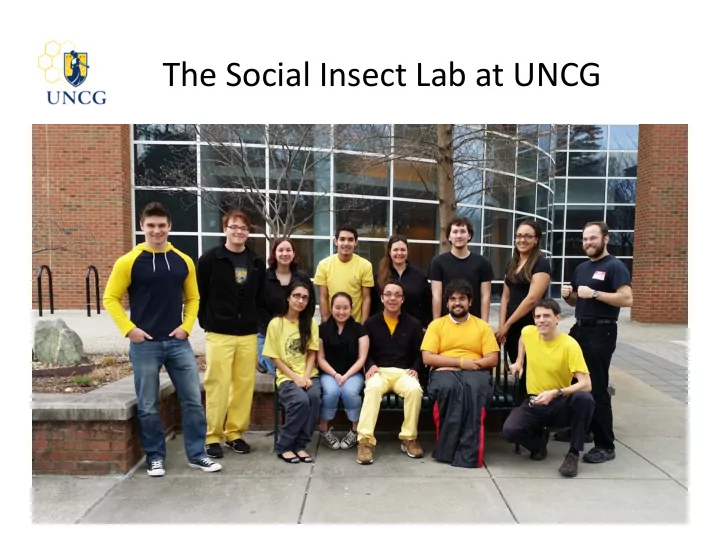

The Social Insect Lab at UNCG
Relevance of Honey Bees
Research Overview
Hygienic Behavior • Detection and removal of unhealthy bees • Leads to improved colony health
Hygienic Behavior • We know a lot about the adult, nurse bees – Hygienic nurses better at detecting unhealthy brood
Hygienic Behavior • We know a lot about the adult, nurse bees – Hygienic nurses better at detecting unhealthy brood • We don’t know a lot about the brood:
Brood Signals! Brood A Brood B Brood C ( X 2 =69.4, d.f.=2, p<0.001)
Active Brood Signal MITE CONTROL Mite Control
Active Brood Signal Hygienic Hygienic Control Extract Mite Extract χ 2 = 3.6, df = 1, p = 0.029
Signal Identification Mite Uncapped GCMS Mite Capped Control Capped
P32 ‐ Hygiene Link P32 is directly P32 Relative Quantity linked to hygienic behavior Control Mite Mite Capped Uncapped Capped
Synthetic P32 100% 80% 60% Capped Uncapped 40% Removed 20% 0% P32 Hexane Control Synthesized P32 applied to wax caps induces hygienic uncapping and removal
Practical Applications • Selection tool for breeding hygienic honey bees • Treatment for highly infested colonies P32 Spray
Review of the Past 14 Years in Numbers Articles published: 68 Presentations given: > 230 Students mentored: 111 Grants received: 28 (>$4.6M) Citizens engaged: > 2500 Bee stings suffered: > 200 Bees studied: >1,000,000
UNCG Honey Bee Research Facility
UNCG Honey Bee Research Facility
Take ‐ Home Messages • Honey bees are interesting insects and important pollinators
Take ‐ Home Messages • Honey bees are interesting insects and important pollinators • UNCG is an excellent place to learn and work
Take ‐ Home Messages • Honey bees are interesting insects and important pollinators • UNCG is an excellent place to learn and work • Research benefits pollinators, the local community, and the global scientific community
Recommend
More recommend